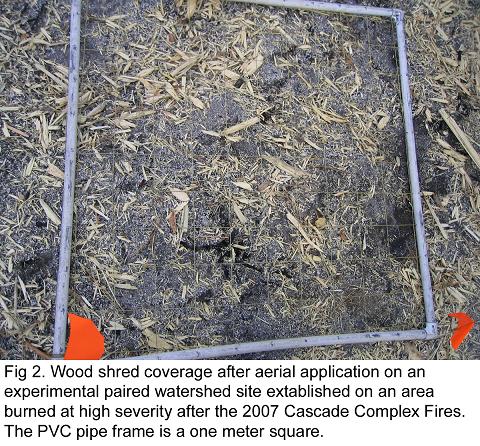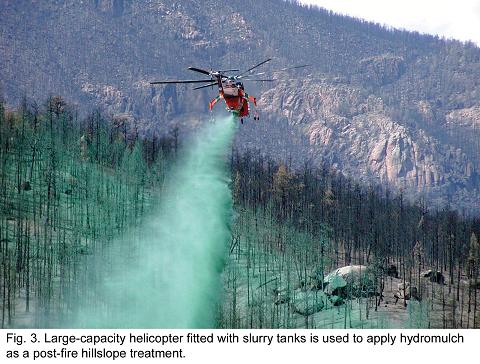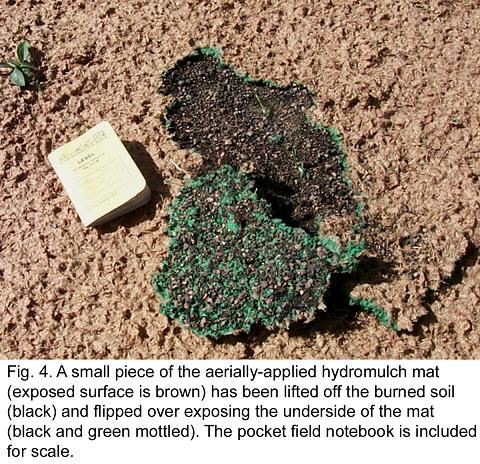Post-fire Treatment Effectiveness for Hillslope Stabilization
| Moscow FSL Home Page | |
| Personnel | |
| Engineering Publications | |
| BAER Tools | |
| Rocky Mountain Research Station | ||
| Forest Service Research | ||
|
|
||
|
Moscow Forestry Sciences Laboratory 1221 South Main Street Moscow, ID 83843 (208) 882-3557 7:30-4:30 M-F |
|
|
|
|
MULCH TREATMENTS
Mulch is material spread over the soil surface to protect soil particles from displacement by rain drop impact and overland flow. Because mulching is an effective ground cover immediately after being applied, it is an attractive choice for post-fire hillslope stabilization. It is often used in conjunction with seeding to provide ground cover in critical areas and to increase the success of seeding by improving moisture retention.The mulches used in post-fire treatments are generally divided into two groups based on how they are applied.
1. Dry mulches–such as agricultural straws and wood materials, are applied without water.
2. Wet mulches–usually referred to as hydromulch, are prepared by mixing the components with water to form a slurry that is applied to the soil surface.
Dry Mulch
During the past decade, aerial application techniques for straw mulch have made it possible to apply mulches more efficiently and to treat inaccessible burned areas, making it a viable treatment alternative for the large fires that occur in the mountainous western U.S. (fig.1).
Agricultural straw mulches often contain non-native seed species that can persist and compete with the re-establishment of native vegetation. BAER teams and land managers prescribe certified "weed-free" straw for post-fire mulching but it is not always available in the locations and quantities needed. Rice straw is less likely to bring in noxious weeds, since rice is grown in moist habitats and successful weeds from rice fields are unlikely to germinate or spread in dry forest environments. Straw mulch has been applied to improve the germination of seeded plants, but some studies have shown little difference in the amount of vegetation cover on mulch-and-seed plots compared to mulch-only plots. Although wood mulching is less common than straw mulching, wood chips, wood shreds, and wood strands (thin wood strips manufactured from non-merchantable timber or production waste, such as WoodStraw&tm;) are increasingly being developed and used for post-fire treatment. Forestry equipment manufacturers are adapting wood chippers and shredders to handle available materials (such as slash, woody debris, and burned timber) and developing application technologies for the output from these devices (fig. 2). Using materials from the local environment reduces the cost and time for transporting mulch materials to the burned area designated for treatment.

Hydromulch
Hydromulches are combinations of various short, bonded organic fibers (wood shreds, paper, cotton, flax, etc.), tackifiers, suspension agents, seeds, etc., that are mixed with water and applied to the soil surface (fig. 3). The matrix formed by the hydromulch holds moisture and seeds on steep slopes, which fosters seeded plant germination while holding the soil in place. Since hydromulch binds to the soil surface, it is very wind-resistant; however, the smooth dense mat has little resistive force against the shear force of concentrated flow (fig. 4). Consequently, hydromulch mitigates water erosion more effectively on short slope lengths where concentrated flow and rill erosion are not as likely as on longer slopes.

There are numerous tackifiers, polymers, bonded fiber, seeds, etc., that can be included in hydromulch mixes. Generally, the tackifier (the "glue" that bonds the fiber to the soil), mulch material, and seeds are selected separately and mixed with water just prior to application. The selection of the tackifier is particularly important as the environmental impacts, performance characteristics, availability, and cost vary widely.
|
The information on this web page has been excerpted from the following publication: Robichaud, Peter R.; Ashmun, Louise E.; Sims, Bruce D. 2010. Post-fire treatment effectiveness for hillslope stabilization. Gen Tech. Rep. RMRS-GTR-240. Fort Collins, CO: U.S. Department of Agriculture, Forest Service, Rocky Mountain Research Station. 62 p. |
USDA Forest Service - RMRS - Moscow Forestry Sciences
Laboratory
Last Modified: